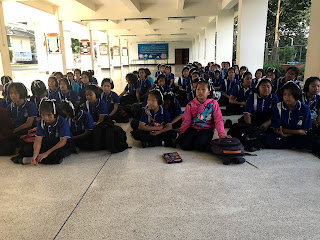Today we drove up north to Chiang Dao which is located about 40 kilometers south of the Myanmar border. We visited the Chiangdao hospital and were given a lecture on both HIV/AIDS and Tuberculosis. This hospital has approximately 500 patients that have HIV/AIDS. Being so close to the border, a lot of these patients are migrants from Myanmar. What was interesting was that these migrants received the same treatment the Thai people did at no cost. It is very important to treat these migrants in order to stop the spread of both HIV/AIDS and TUberculosis. The hospital has a unique program that is run by volunteers. They have a club that meets once monthly for patients affected by these diseases. The volunteers are also affected by the diseases and are able to talk to the patients about how they are doing and educate them. Out of the 500 patients that have HIV/AIDS, 300 of them participate in this club. At the meetings they discuss any problems they might have. Additionally the volunteers make home visits to patients who are unable to come into the hospital. The volunteers can report back to the hospital after making the visits and even bring a doctor back to the patients home if need be. When patients are started on an antiviral therapy for HIV the volunteers make home visits 2-3 times a week to make sure things are going well.
This is a picture of some of the medications they use in the hospital for HIV/AIDS. They are manufactured by the Thai government and are given to both the Thai people and the migrants for free.
We also visited the maternity ward at this hospital which was an interesting experience. Again they take care of a lot of migrant mothers. Migrants can have a contract with the hospital which costs 2000 baht per year (about 60 US dollars) which enables them to have various services in the
hospital covered including child birth. If they do not have a
contract they would have to pay 3000 baht for the birth and care of the mother to be covered. A interesting thing we learned was that during labor patients are not given pain medicine. Instead Thai massage, hot compresses, and occasionally Tylenol is given. One major difference from the US is that when a child from Myanmar is born in Thailand, they do not get citizenship like we do in the states.
This is a picture of the labor and delivery room in the hospital.
The second half of the day we visited the orphanage. One of the most memorable parts of the trip for myself. The orphanage started 20 years ago when there was a big problem with human trafficking near the border. The local police called upon the Sisters of Saint Paul de Chartres to take young women under there wing to protect them from being sold into sex trafficking. A few years after opening, HIV/AIDS was also a big problem in Thailand so the sisters opened up the orphanage to children affected by HIV/AIDS. Now the orphanage is open to both infected and non-infected children, abused children, children under inappropriate care, and children affected by hardships. Additionally the orphanage has a non-profit private school that provides education for kindergarten to secondary level.
The girls got on stage and did a performance that included singing and dancing. They were adorable!
Next we visited the younger children of the school and stood around a circle doing the chicken dance together. So much fun they were adorable.
My favorite part of the day was meeting Miss Nice. She is 7 months old and lives at the orphanage. She had just woken up from her nap but was still such a good camper. I definitely wanted to take this cutie home!










No comments:
Post a Comment